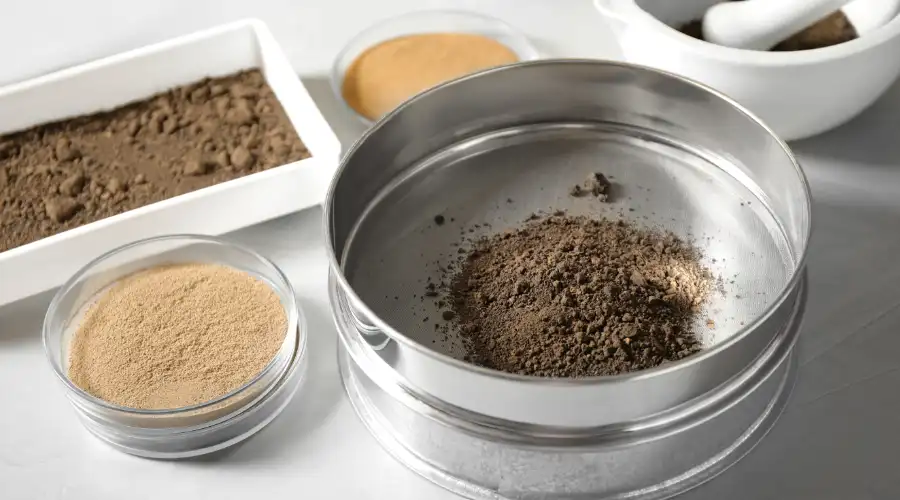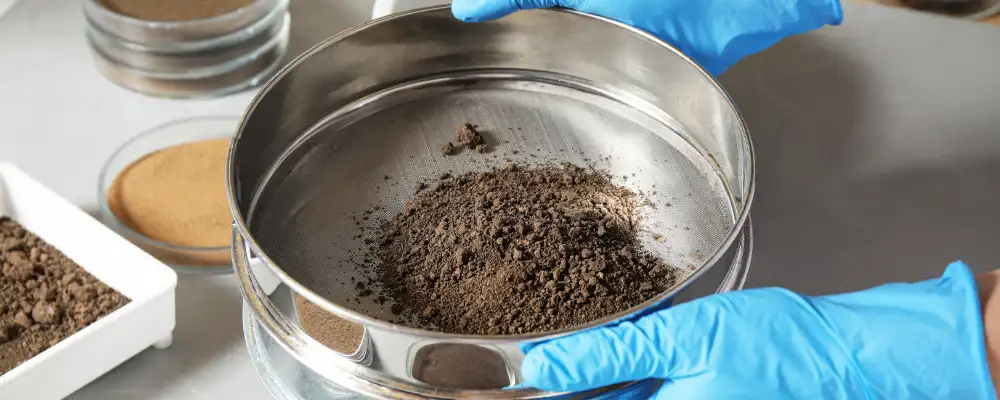What makes a concrete mixture strong and dependable? It is not the adhesive element or the fluid part. Rather, it refers to the fine granular material that helps unify the entire mix. To confirm that the fine particles are correctly sized, professionals perform a procedure known as sieve testing. This process sorts and quantifies the grains of sand applied to buildings, ensuring that each batch has passed quality checks.
Conducting an accurate grain size evaluation of fine materials can determine whether a structure remains intact for years or fails under stress. In this post, let us explore what sieve analysis is, its importance, and more.
Overview of Sieve Analysis of Fine Aggregates
Sieve analysis is a common laboratory method. This helps in determining the gradation or particle size distribution of fine aggregates. In a sieve analysis, the material is passed through a series of sieves with varying mesh sizes, enabling the separation and classification of particles according to their size. Fine aggregate is a granular material of size less than 4.75 mm.
Sieve analysis helps determine whether a material is fine or coarse. This is crucial for meeting performance expectations in terms of construction usability. Sieve analysis is a simple, widely used technique applied to both organic and inorganic materials, as well as to granular materials such as sand, crushed rock, soil, and powders. The results of a sieve analysis enable you to assess the suitability of fine aggregates for concrete and mortar mixes, making it a critical process in material testing and quality control within civil engineering.
Purpose of Sieve Analysis of Fine Aggregate
- Aids in the determination of the fineness modulus, which is the average particle size of a fine aggregate sample.
- Provides a representation of the grain size distribution, illustrating the distribution of particles through various sizes of sieves.
- Determines the general grading of aggregates to indicate if the material is either fine or coarse aggregate.
- It plays a crucial role in determining the viability of fine aggregates for construction purposes, particularly in concrete mixtures.
- Gives a good picture of the uniformity or variability of particle size in a batch of fine aggregate.
- It makes the grading of material into four zones possible, which is crucial for the specification of the right aggregate type for certain construction requirements.
- It helps in the identification of changes in the material source, as any change in fitness modulus indicates a change in aggregate origin.
- It supports quality control and construction consistency by tracking changes in aggregate properties over time.
- Affects the workability and appearance of concrete, so this test is critical to mix design and performance prediction.
- Provides a consistent means to guarantee the fine aggregate complies with project specs and construction requirements.
Sieve Analysis of Fine Aggregate According to IS Code
Sieve analysis is one of the standard laboratory tests that measure the particle size distribution of fine aggregates. The test, according to IS specifications and MORTH guidelines, classifies sand into various grading zones in order to ascertain its appropriateness for concrete construction.
Test Apparatus Required
The following equipment and instruments are required to perform sieve analysis of fine aggregates:
- IS Sieves: Available sizes are 10 mm, 4.75 mm, 2.36 mm, 1.18 mm, 600 microns, 300 microns, and 150 microns. A lid and a pan are also needed.
- Oven: To dry the fine aggregate sample.
- Weighing Balance: To 0.01 g accuracy in order to measure retained weights accurately.
- Tray: To carry and hold the material.
- Brush: Used to brush and transfer material caught on sieves.
- Mechanical Sieve Shaker: To uniformly and effectively sieve for repeatable results.
Sieve Analysis Process for Fine Aggregate

The procedure to carry out the sieve analysis is organised and has to be executed step by step:
Sample Selection
- Take a 1 kg representative sample from a 10 kg lot by quartering the lot to attain uniformity.
- Ensure the sample is dry and free from lumps before testing to allow for accurate separation during sieving.
Sieve Arrangement
- Place the sieves in sequence, beginning with the top 10 mm sieve, followed by 4.75 mm, 2.36 mm, 1.18 mm, 600 microns, 300 microns, and 150 microns sieves.
- Position a pan at the base to catch the finest particles passing through the smallest sieve.
- All sieves should be clean and stacked tightly and evenly aligned to avoid material leakage during shaking.
Sample Loading
- Add the 1 kg sample to the top sieve and close the lid to prevent material loss during agitation.
Mechanical Sieving
- Securely fit the sieve stack in the mechanical sieve shaker.
- Operate the shaker for a minimum of 10 minutes to fully separate the particles.
Mass Measurement
- Once sieving is done, remove each sieve carefully and brush retained particles to ensure none remain stuck in mesh openings.
- Weigh and document the mass of material retained on each sieve using the precision balance.
- Clean each sieve with a brush before weighing it to collect all particles accurately.
Calculations and Analysis
- Calculate the percentage retained on each sieve by taking the retained weight and dividing it by the sample total weight, then multiplying by 100.
Percentage Retained = (Weight Retained on Sieve/Total Sample Weight)×100
- Calculate the cumulative percentage retained and the cumulative percentage passing for plotting purposes.
- Plot the graduation curve to determine the type of graduation.
Requirement for Grading of Fine Aggregate
Fine aggregate to be utilised in concrete should be within one of the four grading zones specified in the IS standards. I.e., Zone I, II, III, and IV. The classification is done on the basis of the percentage retained or passed through a standard set of sieves.
According to IS 383
- Grading of fine aggregate is categorised into four zones (I to IV) based on sieve size distribution.
- If grading falls outside of the limits for any sieve other than 600 micrometres by up to 5%, and the total deviation across sieves does not exceed 10%, the aggregate can still be considered within that zone. This tolerance does not apply to the 600-micrometre sieve, nor to sieves at the coarse limit of Zone I or the fine limit of Zone IV.
- For crushed stone sand, the percentage passing the 150 micrometre sieve may increase up to 20%, without affecting the general 5% tolerance.
The Bottom Line
Sieve analysis of fine aggregate is an important quality control process in construction that facilitates the evaluation of particle size distribution and grading of aggregates into suitable grading zones. The test ensures the fine aggregate conforms to IS standards and is acceptable for use in concrete production.
Precision in sieve analysis enhances mix design, workability, and long-term structure performance. Continuous testing also assists in identifying changes in material sources. This leads to consistent construction quality and project reliability.

